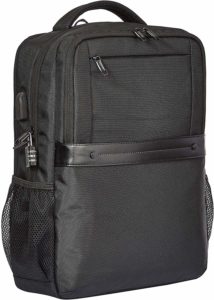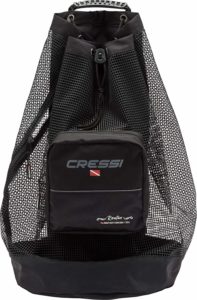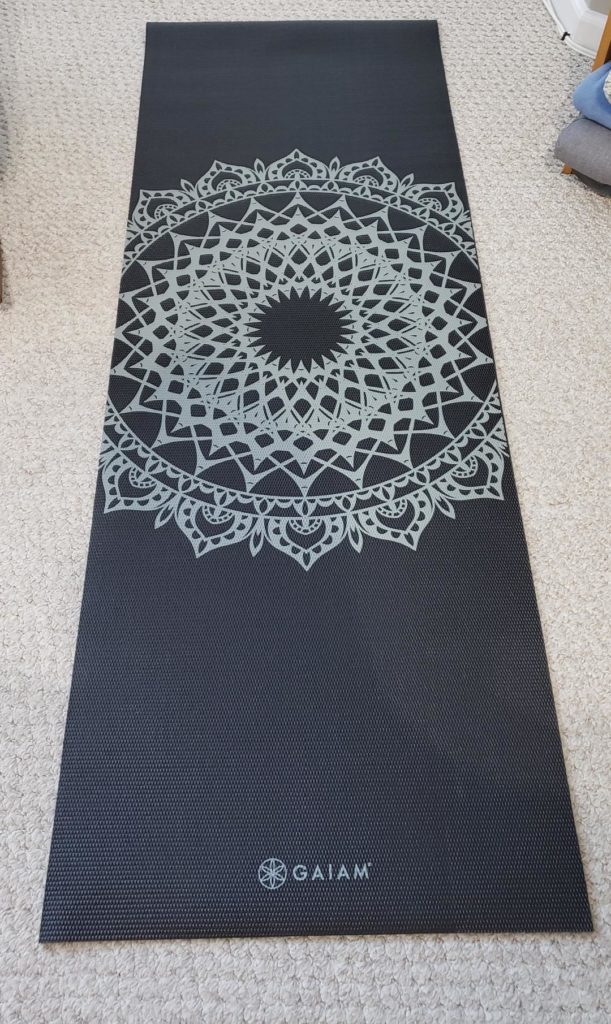Are you shopping for a backpack, either for yourself or as a gift? How do you know which backpack to buy? There are so many to choose from!
This comparison review will help take the weight of wading through all the hype off your shoulders, so you can make an informed decision that is right for you.
I have reviewed several backpacks in the past few months. The chart below looks at a sample of 10 backpacks for sale on Amazon. Important attributes are listed across the top, and the name of the backpack is on the left.
Links to the product page are in blue in the chart. Just right click on the link, then left click on “Open Hyperlink”. As an Amazon Associate I earn from qualifying purchases.
Just click the lower right corner of the chart to expand it.
My reviews for each backpack are below the chart.
 Do you like over-the-top? This backpack.
Do you like over-the-top? This backpack.
The Acer Predator M-Utility 1680D Ballistic Laptop Backpack for Up to 17″ Laptop, is definitely one of the top backpacks you can buy on Amazon, across all the main departments (33) which have backpacks. Not surprisingly, the backpacks that cost the most money have either one or both of these things in common: they are made by a well known brand name/company, and they are highly specialized toward a certain niche. Even though both apply to this backpack, at $149 it isn’t over priced for what you get.
This backpack is targeted toward gamers, those 18 to 49-years-old, more men than women, who report spending an average of 6.5 hours playing video games per week, and playing with friends and family members at least half of that time.
Acer, of course, makes the Acer computer. On the Amazon product page for this backpack is a suggested trio of products which includes the Acer Predator Helios 300 Gaming Laptop, 15.6″; the HAVIT 5 Fans Laptop Cooling Pad for 14-17 Inch Laptop, Cooler Pad with LED Light, Dual USB 2.0 Ports, Adjustable Mount Stand; and of course the Acer Predator Utility Gaming Backpack, Water Resistant and Tear Proof Travel Backpack Fits and Protects Up to 17.3″ Predator Gaming Laptop. That little package wraps up at the tidy sum of $1,668.23.
Acer makes several backpacks which pair nicely with their computers, but the Acer Predator M-Utility 1680D Ballistic Laptop Backpack is the top-of-the-line. When I saw the word “Ballistic” in its name, I excitedly thought I was getting a backpack with bullet-proof armor, designed in response to school shootings.
Not quite. The term ballistic refers to the Nylon fabric that is used on this backpack. Nylon, developed by the DuPont Company as a substitute for Japanese silk, became very popular in the late 1930s as the new material for women’s hosiery.
But as what would become WWII heated up in Europe, DuPont shifted commercial production of nylon to military support. Nylon fibers were used as silk replacement in parachutes, glider tow ropes, aircraft fuel tanks, shoelaces, mosquito netting, and hammocks.
As America’s involvement in the war increased, DuPont scientists wanted to find a way to protect the men in the US Army Air Corp who were often wounded in the upper torso from shrapnel when their planes were shot or as they were parachuting. Another word for this shrapnel, flak, is a shortened form of the German word fliegerabwehrkanone, meaning anti-aircraft gun.
DuPont invented the flak jacket, the toughest nylon of the time with metal plates sewn into the lining. DuPont’s ballistic nylon didn’t stop bullets, but it did help save lives. The flak jacket has evolved into the sophisticated body armor, usually with some type of Kevlar, worn by today’s soldiers and policemen.
Two things distinguish the ballistic nylon from regular nylon: the high denier nylon thread and the ballistic weave. The denier is a measure of the thickness of the yarn. Ballistic nylon will be made from the higher denier nylon thread, usually 1000d and above. The higher the denier, the thicker, heavier, and tougher the thread will be.
More important to ballistic nylon than the denier is the weave. Certain weaves are conducive to preventing snags and tears. A dense, tight weave will resist rips and can be impervious to rain.
This is the ballistic nylon that the Acer Predator M-Utility 1680D Laptop Backpack is made with. It provides excellent protection in all kinds of weather. If your backpack gets stuck halfway in an elevator, bus or subway door, I’m sure you’d rather have the outer material made of ballistic nylon!
The interior fits up to a 17” laptop, with room for your gaming keyboard, headset, mouse, cords, and plenty of other accessories. The second interior section is compartmentalized with thick modular padding. This area also has one large and three small slit pockets, and nylon straps.
Two tall side pockets, a front pocket with a media port and a rain fly, and a top compartment make this the most over-built, extremely padded, roomy backpack I have ever owned!
I haven’t even mentioned the subtle teal trim accents, waterproof exterior zippers, well-padded shoulder straps, luggage sleeve, substantial zipper pulls, and the all-around bad-A vibe you get just being in the same room with this big boy. It’s intimidating, for sure.
Boxy but built for function
When Amazon entered the AmazonBasics Anti-Theft Premium Backpack – Black, in the backpack niche, they went all out to compete with the trendy features:
- USB port on outside of bag, with wire inside that can connect to your device
- Anti-theft; they put a small combination lock through two of the zipper pulls
- Padded space for laptop or tablet
- Padded shoulder straps
- Water bottle holder on each side
- A strip of presumably faux leather across the back to dress it up
- A plethora of pockets, inside and out, slit and zippered
This last positive feature is what distinguishes this backpack from all the others. It is big enough to carry your laptop, your chemistry text book and lab book, and a change of clothes so you don’t smell like your chemistry experiment when you meet that special someone after class. Suffice it to say, you can carry everything you need and a little bit more with this backpack.
But along with that comes the negative feature. It is boxy looking and doesn’t have the cool vibe of the Camelbak Pivot Rolltop. So if you’re the pragmatic type who cares more about function than looks, this could be your top choice.
Functional without frills
The AmazonBasics Campus Backpack for Laptops up to 15-Inches is exactly what it says, a no-frills, plain-jane backpack with a padded compartment for a laptop.
The exterior has a water bottle-type pocket on each side, a zippered compartment on the front segmented from the rest of the pack, and a side zip entrance to the laptop compartment. The shoulder straps are padded. There is no external USB port.
The front interior compartment is roomy, with a 6” deep zippered pocket across the width of the pack. On the front of the zippered pocket is sewn a mesh slit pocket, divided in the middle.
The next interior compartment is separated by the padded laptop divider, which has a wide elastic strap with Velcro closure to hold the laptop in place. The rest of that compartment is unremarkable, and could be well used for books.
While the outside is sleek and unpretentious, you get all the basics on the inside, just none of the “extras”.
Stylish, Functional, and Socially Responsible
The first thing I noticed about the Camelbak Pivot Roll Top Backpack in Black is how light weight it is. No matter how much you carry, it isn’t going to be unnecessarily compounded by a heavy pack.
Next I noted that the outer back surface appears to be water resistant. Since 50% of this bag is made from repurposed material like plastic water bottles, this makes sense. There’s a side pocket perfect for a water bottle, and the opposite side features a zippered pocket. You’ll find a roughly 9×5″ rectangular slit pocket on the outer back. The buckle that secures the rolled top does duty by snapping together over the top of this pocket.
The empty bag holds 20L. You can easily stuff a change of clothes, your lunch, and maybe a book or two. A slightly padded partition allows for a small laptop or tablet. Above that is a zippered compartment just right for keys, a wallet, or an mp3 player. No worries if you don’t have Bluetooth headphones. There’s a small slit at the top of the left shoulder strap for ear bud cords, or a hydration tube.
The shoulder straps don’t have a lot of padding, but they are made of breathable mesh. The straps are lined with a nylon-like strap attached at intervals, so things may be attached by threading underneath the strap (lanyard, spring-loaded retractor, or molle accessory).
I give the CamelBak Pivot Roll Top Backpack high marks for style, functionality, and being socially responsible.
Handle Placement troublesome design decision
This bag has the capacity (90 liters or 25 US gallons) to carry all your SCUBA gear. It measures 15.5” wide and 28.25” high. The bag itself weighs 2.6 lbs.
The Cressi Heavy Duty Mesh Backpack has a drawstring closure, but there is also a zipper running vertically which allows access.
The padded shoulder straps make carrying all your equipment much easier than if you were using a simple gear bag. Sternum straps and a waist belt help keep the pack centered.
Two rugged carry handles, one located at the top of the shoulder straps, and the other mid-back, offer an alternative method of schlepping the bag. The placement of this second handle is a troublesome design decision. When the pack is full and worn on the back, there is the potential for the gear to press that handle into the wearer’s back. I anticipate this would cause discomfort of increasing significance the longer the pack is carried.
The majority of the bag is constructed of flexible, high-density polyester mesh. The bottom of the backpack is made of reinforced PVC for durability. A drain port about the size of a nickel with multiple small holes allows this dense bottom to shed excess water. This facilitates a rinse with a hose while in the backpack to wash off salt, sand or debris.
A zippered pouch on the outside of the main bag may hold smaller or more delicate equipment you do not wish to throw in with everything else. A drain port is in this exterior pouch as well. On the inside of the main bag suspended from the rim is a heavy canvas pouch with a zipper closure. Just as with the exterior pouch, it offers no view of what you may wish to store inside.
This is a specialized backpack designed by Cress, an Italian company with over 70 years experience in the industry. The bag is made in China.
Well-made bag works best for sports, but can be used for school.
The Franklin Sports Boston Bruins Street Pack Backpack – Team Logo Hockey Bag with Hockey Stick Holder – NHL Official Licensed Product is a backpack made more for carrying sports equipment than for transporting a laptop.
If you had to, you could put a small tablet or laptop in the interior compartment. There is a small amount of padding in the back wall of the backpack which rides against your back. The backpack straps are also padded.
The zipper into the main compartment goes from the bottom right corner (facing the bag) to the top left corner. As mentioned, the interior has a very stiff lining and one interior divider.
There’s a front zippered pocket which gives access to the whole front panel. This is an odd design, as anything pushed into the upper portion (behind the logo) will immediately be pulled down by the force of gravity once the backpack is hoisted to the shoulders. The only thing I can imagine might work in this area would be long stiff shin guards or some similar piece of equipment which needs the 16” length of the panel.
Similarly puzzling is a mesh divider across the width of that same front panel, from the zipper down. It is not tight, and serves no obvious purpose that I can see.
An outside mesh pocket is sewn to the bottom right of the bag. The manufacturer designates this as for balls or a water bottle.
The team logo and the manufacturer name are embroidered on the bag. This is well done and looks very sharp. The zipper pulls have a 2-3” cord looped through for an easy grab. There’s a small window on one of the shoulder straps, where identification could be inserted. This is especially nice if your whole team decides to get the same backpack.
The most unique feature of this backpack is the hockey stick holder. These are two strips, roughly 5.5×1.5”, sewn on the left side of the bag, to strap the hockey stick in place. The outermost layer of the strip matches the polyester of the backpack, so when closed that is what is seen. The inner layer is a black soft padding material, perhaps rubber. At the ends of the strip are opposing squares of Velcro to secure the strip and hold the stick in place. With one strap near the top of the bag and one near the bottom, the stick should be secure if properly placed in the straps.
This appears to be a well-made bag, designed more for sports gear than for academic pursuits, although it could be used for either.
Not large, but high quality
The TAJEZZO Sling Backpack Waterproof Crossbody Shoulder Bag Causal Daypack Chest Bag is made with obvious attention to detail. It has a luxury feel. The fabric is a fine weave. The outer zippers come together with a rubber-like covering. The padded shoulder strap can be reconfigured as a waist strap, or switched from left to right. The semi-hard front shell has a unique, attractive design. The back (worn next to the body) has a slit pocket. All of this can be discerned at just the first glance.
If you think of the TAJEZZO as a backpack, you are really going minimalist. Many women’s purses are twice the size of this bag. My 7” Kindle Fire with the bulky kid’s cover fit inside, barely. You would be hard pressed to carry a tablet or laptop any larger than that in this bag. You would need to be very selective about your reading material if using this as a book bag.
The TAJEZZO does have the external USB port. There’s an external zippered pocket, internally sectioned off from the rest of the bag, across the bottom half of the bag.
Internally you’ll find two more slit pockets, one on each side of the bag. The one toward the back is made with a leather-like (who knows? maybe it’s real leather.) partition embossed with the TAJEZZO logo. In front of that is a zippered pocket, with the inner back sharing the leather surface.
I haven’t tested the waterproof claim of this bag, but judging from the construction I would believe them to be credible. As for anti-theft, the only thing that would substantiate that assertion is the bag can be worn in the front making pick pocketing less likely.
I would recommend this bag for travel, for men or women, and for an alternate use as a purse. You may be surprised how much you can carry, but don’t plan to carry large items.
5 Stars.
Designed for Durable, Strong Protective Water-Resistant, and Comfortable for Traveling and Commuter fit up to 14-Inch Laptop
The Targus Sol-Lite Compact Backpack is designed as a streamlined travel/commuter backpack.
This bag will hold up to a 14″ laptop, and still have room for a few additional items. One main compartment dominates the design, but zippered pockets, some hidden, appear on the back side, top flap, and across the front panel. Most of these pockets can be described as narrow and not easy to reach into.
That’s also the case with the main compartment until you unclip the side cinch straps on either side. A laptop and tablet sleeve back against what feels like a hard plastic board covered with minimal padding. Both sides of the interior have web netting pockets; one is zippered.
The exterior is constructed of dense nylon fabric, with an even heavier nylon fabric used for the bottom and as contrast on the shoulder straps, making this backpack one that will stand up well to the elements. Deep water bottle pockets flank the sides; they are gusseted by an elastic band with a pleat of additional material hiding until needed for expansion.
The shoulder straps are well padded, and there’s nice padding on the back as well. A nylon strap handle is in the usual location at the top of the shoulder straps. We also see the newly popular vertical nylon strap sewn in place from top to bottom on the front panel, with a “grab and go” handle in the center. There is no luggage handle pass-through sleeve, but there are several molle-type anchor points, both stationary and elastic, on the shoulder straps, and two wide nylon anchor points on the vertical front panel handle.
Made in China.
Trendy, savvy design will meet student needs
The WindTook 15“ Laptop Backpack for Women and Men Travel School College Purse Daypack in PINK has a unique and compact design.
The main compartment has the laptop sleeve against the outer wall worn to the back. Stacked on the laptop sleeve is the tablet sleeve. An elastic band with Velcro closure attaches to the tablet sleeve to secure both the tablet and the laptop.
To the right is a zippered opening through which the REMOVABLE USB charging port extends. Moving around to the front is a key ring, also removable. Below that a zippered interior pocket will hold most mobile phones. Outside of the zippered pocket and on the inside of the main compartment are slash pockets and pencil pockets. The interior is covered in green nylon fabric. The top of the bag is trimmed in black through which is a drawstring with a spring-loaded toggle clasp.
A (probably faux) leather flap flips over the top of the bag and secures with a magnet about a quarter of the way down on the front.
The rest of the exterior is pink canvas trimmed in pink or black fabric, and adjustable pink nylon straps and handle. There is a water bottle pocket on each side.
This bag is a take-off on the purse-backpack that was so popular several years ago, and I believe will fit right in with today’s boho, hipster trends. The pink adds a feminine flair for the girly girls who love their style.
If bag decides who they are, they can become all they can be
WindTook jumped into the Luggage and backpack market with several offerings. Using quality materials and impeccable construction, consumers are recognizing value. This previously unheard-of brand is gaining a following.
The style I’m examining here is the WindTook Laptop Backpack for Women and Men Molle Travel Computer Bag School College Daypack Suits 15.6 Inch Notebooks.
Let’s break it down, according to the name. It is targeted for women and men. I suppose women are listed first because the featured color is purple, a traditionally female color. Not wanting to alienate half of their customer base, they added men too.
Molle (pronounced like Molly) is the webbing system on the front pocket of this pack. It consists of nylon straps anchored by being sewn in even intervals, establishing a grid pattern. The molle weave is accomplished when the long straps of the accessory you wish to attach are woven in and out of the grid on the pack, and then tucked back into the accessory. Alternate uses can include snapping carabineers over the webbing, or using pin-on or clip-on spring-loaded retractable gear keepers. There is also molle webbing as well as a D-ring on the right and left water-bottle holders.
Also on the front pocket, going across the width of the bottom, is a Velcro-like material you can slap opposing Velcro-like pieces to. WindTook suggests you could put a name tag there. I’ve seen a fly fishing company put the opposing Velcro on the back of a fly patch to have flies accessible, and let the just-used ones dry before shutting them up in a fly box. If you think about it, there’s no end to the possibilities…Velcro a small solar panel to soak up energy while you are hiking, then you can have power for your phone (whether or not you have a signal).
So far this has been treated as tactical gear. The gears change a little when the description continues with Travel, Computer Bag School College Daypack Suits 15.6 Inch Notebooks. This sounds academic or technical with perhaps the exception of Travel. When you travel you want to take everything you need. This bag has room-galore.
The main compartment does have a laptop compartment as described, and it is nicely padded.
Despite being called a Computer Bag, there is no charging port!
Riding piggyback on the laptop compartment is a tablet sleeve, also padded. Then there’s still room for notebooks, textbooks in this same compartment. The second interior compartment is cavernous and without dividers, but does have one zippered pocket on the wall to the outer pocket.
The front pocket has two main slit pockets, with places for pins, etc. This is one area I would like to see developed a little better. There are of pockets here, but I would like to see some zippers in this part, maybe a clip for quick access to keys, etc.
On the sides above the water bottle holders are expansion straps to cinch up any slack and keep things tight. The back and straps are well padded. Also in the back is a “hidden” zippered pocket which may be difficult for someone to get at if you are wearing the backpack. The zipper pulls are knotted nylon cord.
Conclusion: This bag tries to be tactical and technical both, and succeeds at being neither. Still it has a lot of nice features I value in a backpack:
- Quality Construction
- Exterior Water bottle Holder(s)
- Space Galore
- Good Padding
Then some things I’d like to see improved:
- Decide who you want to be, and then embrace it
- Put in a charging port if you call yourself a Computer Bag
- Flesh out the front interior pocket with zippers, clips, webbing
Rating: Four very strong stars.
Shout out to



























